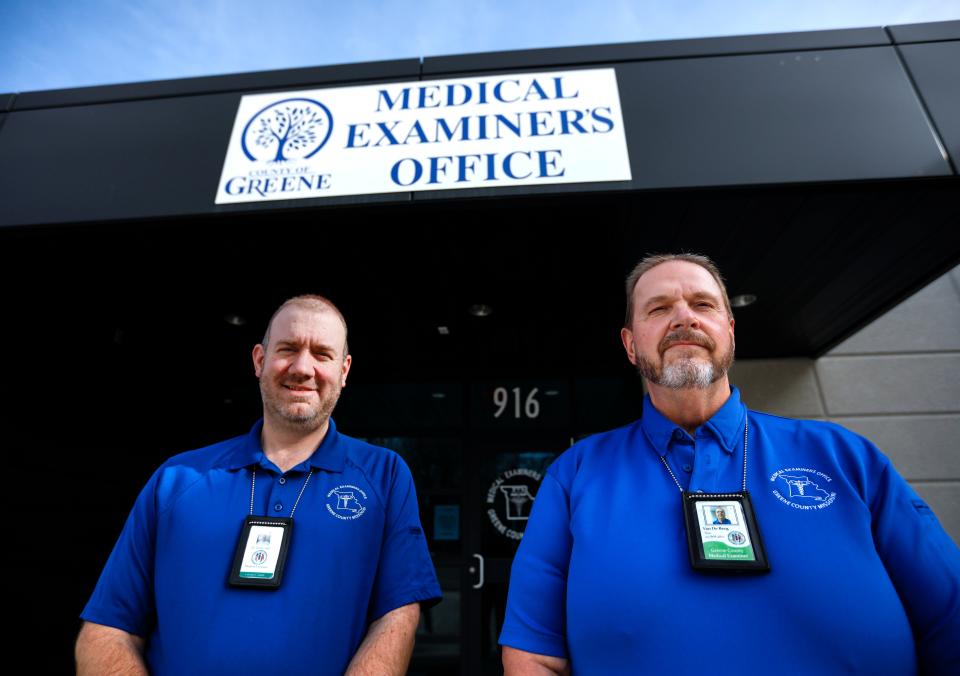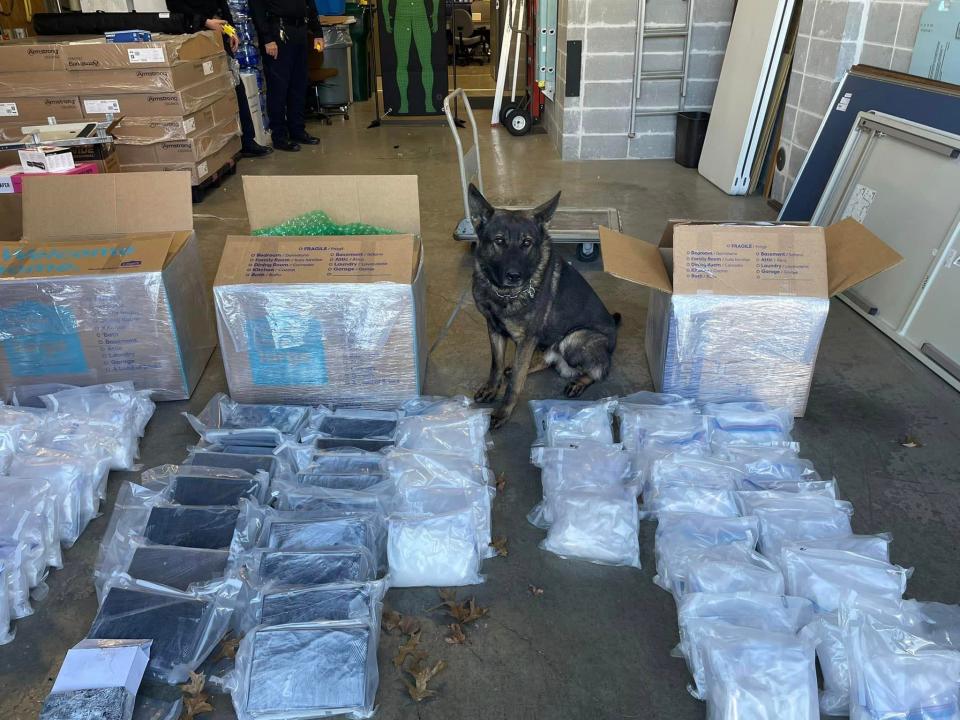Medical examiner: 'Strong culture of meth use' persists in southwest Missouri
Meth is still a "huge, huge problem" in southwest Missouri, at least according to the cases seen by Greene County Medical Examiner Dr. Deiter Duff and Chief Forensic Investigator Tom Van De Berg.
A paper published in the November/December 2022 issue of the Journal of the Missouri State Medical Association reported deaths due to opioid overdoses have risen in Missouri by 15% from 2020 to 2021.
Greene County saw an increase in opioid-related overdoses as well in that time period, but it wasn't in isolation. What's killing people here, the local examiners say, is an increasingly popular combination of meth and opioids.

More:Springfield EMS is seeing more overdoses each year. It could cause a deadly domino effect.
“The highest category each year has been the combination of methamphetamine and fentanyl," Van De Berg said in an interview with the News-Leader.
In 2022, the Springfield Fire Department responded to 407 overdose calls, a decline from 2021's total of 463. However, call volume remains higher than it was in 2019 and 2018, according to Fire Chief David Pennington.
While first responders lack definitive information about what substances cause each overdose they respond to, the medical examiner's office conducts toxicology testing on each case it receives.
“There are cases where there are no indications. We see frequently people aren’t there alone when they’re using, so people will clean everything up — all the paraphernalia and evidence of drugs is gone — so we just routinely test that on every case we bring in," Van De Berg said.
In 2021, 57 overdoses were from a combination of meth and fentanyl, 46 from fentanyl and 42 from meth. Though the medical examiner's office is still waiting on toxicology results for 45 cases from 2022, so far they've seen 46 deaths due to a combination of fentanyl and methamphetamine, 34 from primarily fentanyl and 39 from primarily meth. According to Duff, the majority of overdose victims seem to be young- to middle-aged adults, “although others are certainly affected.”
Even now, southwest Missouri has "a strong culture of meth use"
Ten years ago, Van De Berg explained, "we would walk into meth labs all the time." Restrictions on products containing pseudoephedrine, a main ingredient in methamphetamine, have made manufacturing less common in southwest Missouri. However, the supply of meth seems to be just as steady.
"There’s a strong culture of meth use here. Now with Sudafed being behind the counter and regulated, I can’t tell you the last time I saw a meth lab. But we see more meth than ever because it’s cheaper to bring in and you don’t have to worry about manufacturing and people smelling it and your lab blowing up," Van De Berg said.

Because of that culture, misconceptions surrounding methamphetamine still circulate, such as the idea that someone cannot die from methamphetamine.
"We hear, somewhat frequently, ‘We didn’t know you could overdose on methamphetamine,’ or ‘We didn’t know methamphetamine could kill you by itself,’" Duff said. "So I really think that belief is out there. Methamphetamine is just a huge, huge problem.”
More:The story behind a 165-pound meth bust on Interstate 44 in Greene County
And it's not just limited to overdoses — Duff and Van De Berg often see high levels of methamphetamine in cases of vehicular accidents.
"A lot of the motorcycle and motor vehicle crashes, everybody knows drunk driving — so, alcohol — is a factor in a lot of those," Van De Berg said. "But we see a ton of people driving around with high levels of methamphetamine, and there are a lot of them driving around with a level high enough that if they didn’t die in the crash, they easily could have died from the level of methamphetamine."
In general, the medical examiner's office is seeing higher levels of methamphetamine and fentanyl in people's systems, though they think it is due to users developing a tolerance.
"We think that’s just a response to people using it chronically and needing to take more for the same high," Van De Berg said.
Fentanyl in a new form, new dangers
Though methamphetamine is still the big problem in the area, Van De Berg and Duff did note how popular fentanyl has become.
“In 2015, it was first just starting to come on the scene (in St. Louis) and everybody was like, ‘Why is there fentanyl in this person’s system?’" Duff said. "And now we just expect it. We see it all the time.”
The way people obtain fentanyl has changed, too: While transdermal patches were the norm for the first several years, now it's mostly in pill form.
More:Springfield man indicted for drug trafficking after nearly 800 grams of fentanyl found in his home
"I don’t remember the last time I saw a fentanyl patch," Van De Berg said.
Another thing they have noticed is a shift in the way people talk about fentanyl, which is 50 times stronger than heroin, according to the Centers for Disease Control and Prevention. Often, Duff said, people tell law enforcement that someone was doing heroin when it turns out to be fentanyl.
“I wonder if on the street, they’re saying heroin, sort of like some people say, ‘I’m going to have a coke,’ and that might mean a Sprite or root beer or anything. I have a feeling that same kind of terminology is being used for heroin — they'll say, ‘We’re doing heroin,’ but it’s fentanyl.”
Drug users are 'playing with fire'
Duff believes that the majority of the overdoses that come into the medical examiner's office are accidents.
"We don’t believe they intended to have (a fatal) outcome. Their intention, probably, was to feel better," he said. "... Some of them don’t really care what they’re putting in their body; some of them might not know what they’re putting in their body, but many of them I don’t think realize the real danger."
When people receive fentanyl at a hospital, such as cancer patients, it's used under supervision and there is no question about the drug's origin. But drugs obtained illegally can have varying potency or chemical makeup, with deadly results.
More:Diabetes, substance use and mental health top list of Springfield's health priorities
"Every time they get drugs on the street, you have no idea what the potency of this batch is compared to what you took yesterday. It’s different every time and there’s no way to know," Van De Berg said.
In addition to the drug itself, the body's reaction isn't always predictable.
"There’s overlap between what levels people can tolerate and what levels might be deadly. Now, the question of what levels cause death on a certain day, we don’t know the answer to that," Duff said. "It’s kind of a classic playing with fire situation. They just don’t know what the effect of the drug is going to be on their body on that particular day."
Susan Szuch is the health and public policy reporter for the Springfield News-Leader. Follow her on Twitter @szuchsm. Story idea? Email her at sszuch@gannett.com.
This article originally appeared on Springfield News-Leader: While opioids make headlines, meth still 'huge problem' in Ozarks

